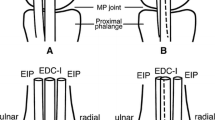Abstract
The aim of this study was to assess the relation between the insertions of the distal tendinous slips, the muscle bellies and the innervation pattern of the abductor pollicis longus (APL) muscle and of the extensor pollicis brevis (EPB). The upper extremities of 31 frozen cadavers were dissected under magnifying lenses to describe the distribution of the posterior interosseous nerve (PION). The number and the distribution of distal tendinous slip insertions of the APL muscle were variable. Two superficial and deep distal tendon groups were noted. The separation into superficial and deep muscular parts of the APL was frequent (87%). The EPB muscle was generally constituted by one muscle belly and one tendinous slip (93.5%). The innervation by the PION to the APL and EPB muscles was classified into five types. The specific innervation between superficial and deep muscular parts of the APL muscle, the specific innervation of the deep muscle bellies and the independence of the superficial and deep distal tendon groups of the APL muscle are arguments in favor of a complex functional role of the APL motor unit in thumb mechanics. However, no independence of the tendinous slips in the two distal tendon groups and no correlation between the number of tendinous slips and muscle bellies or innervation were observed. These limit the functional role of the two independent superficial and deep musculotendinous APL motor units. The use of the APL tendon for interposition arthroplasty, for tendon transfer or tendon translocation seems logical, particularly if using one of the two distal tendon groups.







Similar content being viewed by others
References
Aydinlioglu A, Tosun N, Keles P, Akpinar F, Diyarbakirli (1998) Variations of abductor pollicis longus and extensor pollicis brevis muscles: surgical significance. Kaibogaku Zasshi 73:19–23
Bouchlis G, Bhatia A, Asfazadourian H, Touam C, Vacher C, Oberlin C (1997) Distal insertions of abductor pollicis longus muscle and arthritis of the first carpometacarpal joint in 104 dissections. Ann Chir Main Memb Sup 16:326–338
Brandsma JW, Van Oudenaarde E, Oostendorp R (1996) The abductores pollicis muscles. Clinical considerations based on electromyographical and anatomical studies. J Hand Surg [Br] 9:218–222
Branovacki G, Hanson M, cash R, Gonzalez M (1998) The innervation pattern of the radial nerve at the elbow and in the forearm. J Hand Surg [Br] 23:167–169
Britto JA, Elliot D (2002) Thumb function without the abductor pollicis longus and extensor pollicis brevis. J Hand Surg [Br] 27:274–277
Chitnis SL, Evans DM (1993) Tendon transfer to restore extension of the thumb using abductor pollicis longus. J Hand Surg [Br] 18:234–238
Cho KO (1970) Translocation of the abductor pollicis longus tendon. A treatment for chronic subluxation of the thumb carpometacarpal joint. J Bone Joint Surg Am 52:1166–1170
Elgafy H, Ebraheim NA, Rezcallah AT, Yeasting RA (2000) Posterior interosseous nerve terminal branches. Clin Orthop 376:242–251
Khoury Z, Bertelli J, Gilbert A (1991) The subtendons of the abductor pollicis longus muscle. Surg Radiol Anat 13:245–246
Melling M, Wilde J, Schnallinger M, Schweighart W, Panholzer M (1996) Supernumerary tendons of the abductor pollicis. Acta Anat 155:291–294
Missankov AA, Sehgal AK, Mennen U (2000) Variations of the posterior interosseous nerve. J Hand Surg [Br] 25:281–282
Neviaser RJ, Wilson JN, Gardner MM (1980) Abductor pollicis longus transfer for replacement of the first dorsal interosseous. J Hand Surg [Am] 5:53–57
Revol MP, Lantieri L, Loy S, Guerin-Surville H (1991) Vascular anatomy of the forearm muscles: a study of 50 dissections. Plast Reconstr Surg 88:1026–1033
Roh MS, Strauch RJ, Xu L, Rosenwasser MP, Pawluk RJ, Mow VC (2000) Thenar insertion of abductor pollicis longus accessory tendons and thumb carpometacarpal osteoarthritis. J Hand Surg [Am] 25:458–463
Saehle T, Sande S, Finsen V (2002) Abductor pollicis longus tendon interposition for arthrosis in the first carpometacarpal joint: 55 thumbs reviewed after 3 (1–5) years. Acta Orthop Scand 73:674–677
Segal RL, Wolf SL, Decamp MJ, Chopp MT, English AW (1991) Anatomical partitioning of three multiarticular human muscles. Acta Anat 142:261–266
Van Oudenaarde E (1991) Structure and function of the abductor pollicis longus muscle. J Anat 174:221–227
Van Oudenaarde E, Oostendorp R (1992) Significance of the innervation pattern of the human abductor pollicis longus muscle. J Anat 181:155–159
Author information
Authors and Affiliations
Corresponding author
Rights and permissions
About this article
Cite this article
Dos Remédios, C., Chapnikoff, D., Wavreille, G. et al. The abductor pollicis longus: relation between innervation, muscle bellies and number of tendinous slips. Surg Radiol Anat 27, 243–248 (2005). https://doi.org/10.1007/s00276-004-0286-3
Received:
Accepted:
Published:
Issue Date:
DOI: https://doi.org/10.1007/s00276-004-0286-3




